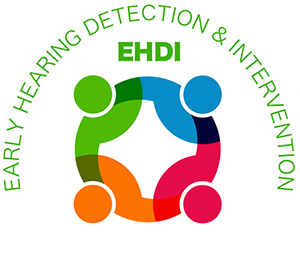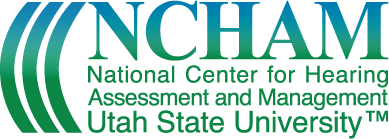Wisconsin: Extended EHDI/UNHSI Information
Wisconsin's Birth to 3 Program - Determining Eligibility for Children with Hearing Loss
The process for determining eligibility for early intervention is the basis for determining eligibility for children with hearing loss.
A child is eligible for early intervention services under the Birth to 3 Program if the evaluation conducted by the early intervention team determines that the child is developmentally delayed or that the child has a diagnosed physical or mental condition which will likely result in developmental delay. A determination of high probability that a child's diagnosed condition will result in a developmental delay must be based upon the team's informed clinical opinion supported by a physician's report documenting the condition. High probability implies that a clearly established case has been made for a developmental delay.
Early intervention team members.
Any early intervention team performing an evaluation must include a service coordinator and at least one member who has expertise in the assessment of both typical and atypical development and expertise in child development and program planning. Parents should be involved throughout the evaluation process. Members of the early intervention teams must be from two different disciplines in the areas of the child's suspected needs.
Therefore, for a child with a diagnosed hearing loss, one or more members of the early intervention team must be able to interpret audiological reports and understand the developmental impact of hearing loss.
Eligibility for a child with diagnosed hearing loss.
The regulations for the Birth to 3 Program do not base eligibility on specific types or degree of hearing loss. There is no required decibel loss nor are children with unilateral hearing loss excluded.
Once a child with a diagnosed hearing loss is referred, the early intervention team needs to determine whether the child's hearing loss is likely to result in a developmental delay. The team needs to consider factors such as the type and degree of the hearing loss, the presence of other conditions, and the potential effects of the hearing loss on the development of the child. The team should make use of the scientific evidence about the long-term developmental consequences of hearing loss in infants and toddlers. A child with a hearing loss does not need to demonstrate a developmental delay to be eligible for the Birth to 3 Program.
If the early intervention team determines that the child's hearing loss is not predicted to result in developmental delay, they must offer to reconsider the child's eligibility within 6 months. The early intervention team should also provide information about, and offer to refer the family to, community services that may benefit the child and family.
PDF Version: Wisconsin's Birth to 3 Program—Determining Eligibility for Children with Hearing Loss [PDF]
Principles for Best Practices in Serving Infants and Toddlers Who Are Deaf or Hard of Hearing and Their Families
Services and supports for Wisconsin infants and toddlers who are deaf or hard of hearing and their families are family-centered, interdisciplinary, and sensitive to diverse cultures and values. (Birth to 3-UNHS Workgroup, 2000; Connecticut Birth to Three System, 1999; DHFS Regional Networking Workshops, 1995; HI PREFACE, 1998; JCIH, 2000).
Families play a primary role in evaluation, assessment, and service provision. Therefore families must:
- Receive unbiased information from knowledgeable professionals about resources for informed decision making. Families receive information on pertinent state and national organizations.
- Be linked to the community of people who have children who are deaf or hard of hearing.
- Be linked to the communities of people who are deaf or hard of hearing
- Be informed of opportunities for participation in activities that promote information sharing.
- Play a central role in determining the communication avenues used by the child and family, considering:
- Parents' preferences, given the full spectrum of choices and resources/organizations supporting each choice
- The family's strengths, needs and abilities
- The child's strengths, needs and abilities
- The child's early communication attempts
- The child's language development
- The child's overall developmental progress
- The parents' understanding that communication choices made can be changed as the family and child change
- Be given broad information about resources related to hearing loss such as:
- assessment strategies
- sensory devices
- amplification choices
- deaf community resources
- family organizations
- communication techniques
- communication development in sign language, oral English, Cued Speech
- language development
- educational options
- medical services such as otolaryngology (ENT)
- genetic counseling
- financial resources
- Be provided information about financial supports available and parent rights as identified in state and federal legislation.
- Receive services and supports that are culturally competent including:
- Sensitivity to the first language of the family
- Sensitivity and awareness of ethnic and cultural values that impact on the family's "natural" style of interaction and how the impact of the child's hearing loss and communication needs may affect that interactive style
- Sensitivity to family values and the family's comfort with receiving assistance and support from persons outside the culture
- Knowledge about the culture and values of deaf and hard of hearing people
Birth to 3 Programs support the ongoing hearing screening, referral, and assessment of infants and toddlers. Therefore:
- Infants with a hearing loss are referred to the Birth to 3 Program as soon as possible after confirmation by an audiologist.
- Infants identified through UNHS and as having a hearing loss are enrolled in a Birth to 3 Program before 6 months of age.
- Infants and toddlers with suspected hearing loss who are referred to Birth to 3 Programs are referred to an audiologist for an evaluation.
- Infants and toddlers enrolled in Birth to 3 Programs should be screened for hearing loss every six months.
- Infants and toddlers with normal hearing who have High-Risk Registry indicators for hearing loss should have their hearing monitored every 6 months by an audiologist.
- Children with identified hearing loss will receive vision screening within 6 months of identification and annually thereafter to identify potential late-onset vision disorders.
- Information is provided to all families in Birth to 3 Programs about developmental milestones in hearing and communication.
Personnel who provide supports and services are knowledgeable about the developmental characteristics, communication, language, and technology needs of infants and toddlers who are deaf or hard of hearing. Preservice and inservice training programs must provide early intervention personnel with information and resources to understand the potential impact of hearing loss on learning and communication needs.
- Team members recognize, respect, and are able to support the family's natural transitions through confirmation of hearing loss and each decision-making stage.
- Evaluation and assessment include the following:
- Degree and type of hearing loss (audiometrics)
- Communication development which may include:
- verbal and non-verbal communicative behaviors
- receptive and expressive prelinguistic and linguistic development in signed, oral, and sign-supported oral communication
- emergent literacy skills
- Social development, parent-child interactions, social play development
- Cognitive development which may include:
- verbal or language-based cognitive skills
- non-verbal cognitive skills
- Fine and gross motor development
- Adaptive development
- Information is collected from:
- Observations of the child and family
- Child's audiologist and audiological reports
- Parents and other primary caregivers, if any
- Medical reports from geneticist, otolaryngologist and primary care provider
- Professionals, especially service coordinators, are knowledgeable about local, state, regional, and national educational programs and resources for infants and children who are deaf or hard of hearing.
- Professionals are knowledgeable about working with infants and toddlers within the context of their family and community.
- The team must have composite knowledge about:
- hearing loss
- assessment
- amplification devices
- acoustic environment
- language development
- communication techniques
- educational options
- the developmental impact of hearing loss
- resources within the deaf community
- At least one team member is knowledgeable about the communication options appropriate for children who are deaf or hard of hearing, is able to interpret audiological reports, and shares this knowledge with other team members.
- Whenever possible, early intervention services are provided by a teacher or therapist trained specifically in intervention for young children who are deaf or hard of hearing.
Service delivery is flexible, includes a broad array of program options, and respects the family's priorities.
- Service coordinators play a primary role in providing information and resources and in facilitating partnerships between families and various service providers and among the service providers.
- Services and supports are provided in natural environments, including the home and other settings where typically developing peers participate (e.g., child care, Early Head Start).
- Play-based center programs include typical language peers and, when possible, peers who are deaf and hard of hearing.
- Services from a Deaf Mentor are available for families who choose to participate.
- Families and providers explore communication options to identify a preferred communication mode(s).
- Families who choose are linked with other parents whose children have a hearing loss.
- Whenever possible services and supports are provided in collaboration with district and/or CESA staff, including teachers of the deaf and hard of hearing and outreach specialists for support in providing appropriate child and family services.
- There are members of the team who can assist the family in learning about the functioning and maintenance of hearing aids or equipment.
- Team members help facilitate the development of effective parent-child interaction.
- Members of the team provide services to the child and parents in the preferred communication mode or collaborate with someone who can provide such services.
- Team members provide support and technical assistance to the community agencies and programs in which the child and family are participants.
Staff who provide supports and services to the child and family are involved in planning transitions to any new setting, including transition to school and other services.
- Staff supporting a child are part of the transition planning from one agency or program to another.
- Ideally, the Birth to 3 Program will contact the local school district by the child's second birthday to inform the district of the child's eventual transition to school and the type of service(s) that may be needed.
- Birth to 3 staff and other service providers are participants in the transition planning conference. Interpreter services are provided, if needed.
- Birth to 3 program staff participates in the IEP Team Meetings that:
- evaluate the child to determine the child's eligibility for special education and related services, and the educational needs of the child;
- develop an individualized education program for the child;
- determine the special education placement for the child.
- consider supports the family may need to meet the child's needs such as sign language instruction and information on assistive technology.
References:
Wisconsin Birth to 3—UNHS Workgroup. A workgroup comprised of consumers, teachers of the deaf, audiologists, and early intervention specialists. 2000-2001.
Connecticut Birth to Three System (October 1999). Service Guideline 5. Young Children who are Hard of Hearing or Deaf: Intervention Guidance for Service Providers and Families.
HI PREFACE: Information Pertinent to Young Children Who are Deaf and Hard of Hearing (1998). CESA 6.
Joint Committee on Infant Hearing (JCIH). Year 2000 Position Statement: Principles and Guidelines for Early Hearing Detection and Intervention Programs. http://professional.asha.org/infant_hearing/y2kpstn_stmnt.htm
Supporting Children Ages Birth to 6 Years who are Deaf and Hard of Hearing and Their Families. Summaries from Regional Networking Workshops (1995). Wisconsin Department of Health and Family Services, Wisconsin Department of Public Instruction, Center for the Deaf and Hard of Hearing, Milwaukee.


